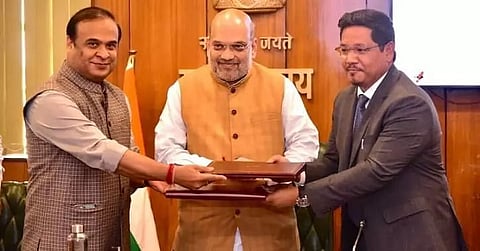
- Home
- Live Blog
- Breaking News
- Top Headlines
- Cities
- NE News
- Sentinel Media
- Sports
- Education
- Jobs

Niraj Bora
(Cotton University. He can be reached at iamfamous1277@gmail.com)
The agreement to resolve six disputed points along the Assam-Meghalaya border is a model for others. Tuesday's agreement between Assam and Meghalaya to end their boundary disputes in six of the 12 areas, where discord persisted, is a welcome first step. The agreement signed by Assam Chief Minister Himanta Biswa Sarma and his Meghalaya counterpart Conrad Sangma, in the presence of Home Minister Amit Shah, also sets the stage to resolve differences in the remaining six areas. Based on a draft resolution of January 29 between the two states, the agreement covers Tarabari, Gizang, Hahim, Boklapara, Khanapara-Pillangkata and Ratacherra under the Kamrup, Kamrup (Metro) and Cachar districts of Assam, and the West Khasi Hills, Ri-Bhoi and East Jaintia Hills districts of Meghalaya. By adopting a give-and-take approach, the two states have demonstrated that knotty boundary issues can be resolved — in this case, partially to begin with — if there is a will to agree. Of the disputed territory — a little over 36 square kilometres — the two States will get a near equal share, enshrining the sharing principle that might serve as a template to resolve other boundary disputes in the Northeast. Assam, the mother State from which other states were carved out in the Northeast, currently has boundary disputes with Arunachal Pradesh, Mizoram and Nagaland. As the Home Minister underscored in Delhi, the spirit shown by Mr Sarma and Mr Sangma should be used in other disputes as well. People living in the six disputed areas should be allowed to choose where they want to live. While Mr Sarma has blamed the Congress for allowing the dispute between Assam and Meghalaya to fester, Nandita Das, Congress MLA from the Boko, alleged that in three of the six "resolved sectors", there was no give and take. The agreement requires delineation and demarcation by the Survey of India as well as parliamentary approval. One can only hope that the right lessons will be drawn by Assam, Arunachal Pradesh, Mizoram and Nagaland from Tuesday's accord to understand the other's point of view and come to agreements. In July 2021, five policemen and a civilian from Assam were shot dead in violent clashes with their Mizo counterparts at a disputed point between Assam and Mizoram. The clash came right after a meeting that Mr Shah had had with the Chief Ministers of northeastern states to resolve boundary disputes. It is imperative that Assam and the other states locked in dispute use goodwill and the good offices of the Centre. Rather than entrusting security to paramilitary forces, one confidence-building measure could be to deploy State police without arms wherever possible. It would be a signal that all states are committed to resolving their disputes peacefully. For the moment, Tuesday's agreement is a moment to savour.
Using a give-and-take method, the two countries have shown that thorny border issues can be overcome — at least in part — provided there is a will to reach an agreement. The two states will obtain a nearly equal portion of the disputed land, which is just over 36 square kilometres, enshrining the sharing concept that might serve as a model for resolving future border disputes in the northeast. Assam, the mother state from which other northeastern states sprung, is now embroiled in territorial conflicts with Arunachal Pradesh, Mizoram, and Nagaland. Mr Sarma and Mr Sangma's spirit should be employed in other issues as well, as the Home Minister stressed in Delhi. The residents of the six contentious regions should be relocated. They should be able to select where they wish to reside. While Mr Sarma has criticized the Congress for allowing the Assam-Meghalaya issue to fester, Nandita Das, a Congress MLA from Boko, has claimed that there was no give and take in three of the six "settled areas". The agreement requires the Survey of India's delineation and demarcation, as well as parliamentary approval. One can only hope that Assam, Arunachal Pradesh, Mizoram, and Nagaland would learn from Tuesday's agreement to better understand each other's perspectives and reach accords. Five Assam police officers and a civilian were killed in fierce skirmishes with their Mizo counterparts in July 2021 at a disputed site between Assam and Mizoram. The confrontation occurred just after Mr Shah met with the Chief Ministers of northeastern states to discuss border concerns. Assam and the other states embroiled in a conflict must make advantage of the Centre's goodwill and good offices. Instead of delegating security to paramilitary troops, one confidence-building move may be to deploy unarmed State police wherever practicable.
It would send a message that all countries are committed to peacefully settling their differences. For the time being, Tuesday's accord is something to celebrate. One can only hope that Assam, Arunachal Pradesh, Mizoram, and Nagaland would learn from Tuesday's agreement to better understand each other's perspectives and reach accords. Five Assam police officers and a civilian were killed in fierce skirmishes with their Mizo counterparts in July 2021 at a disputed site between Assam and Mizoram. Mr Shah had met with the Chief Ministers of northeastern states to address border problems when the fight erupted. Assam and the other states embroiled in a conflict must make advantage of the Centre's goodwill and good offices. Instead of delegating security to paramilitary troops, one confidence-building move may be to deploy unarmed State police wherever practicable. It would send a message that all countries are committed to peacefully settling their differences. For the time being, Tuesday's accord is something to celebrate.